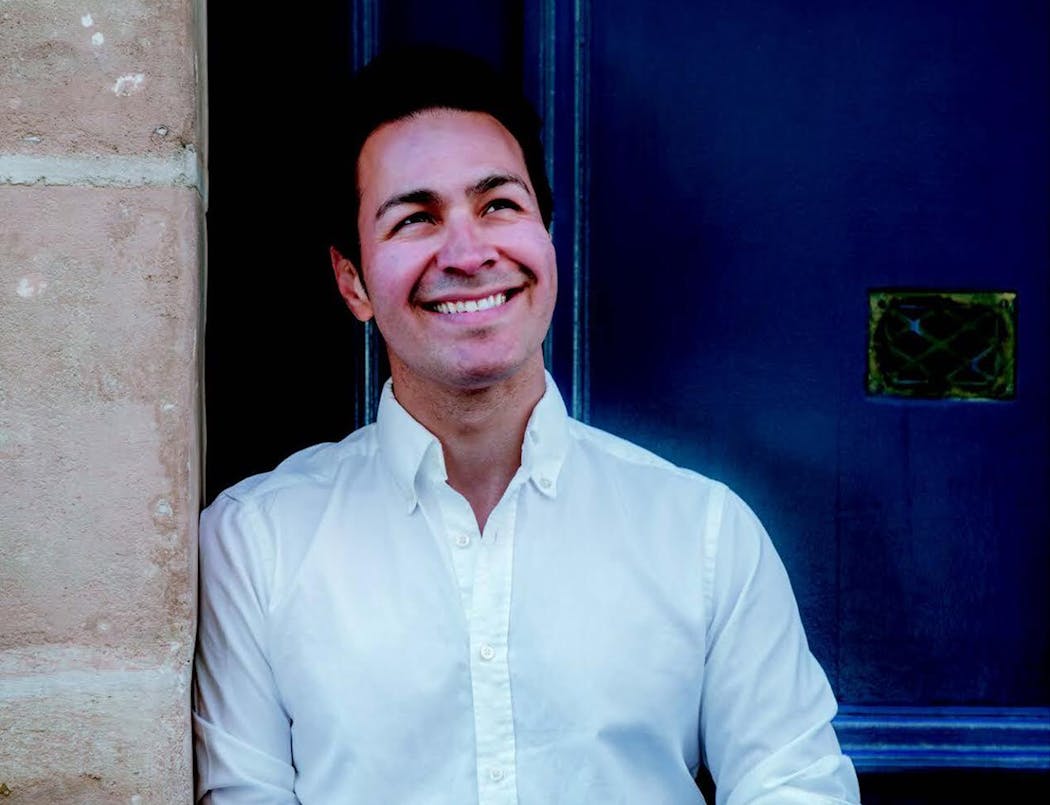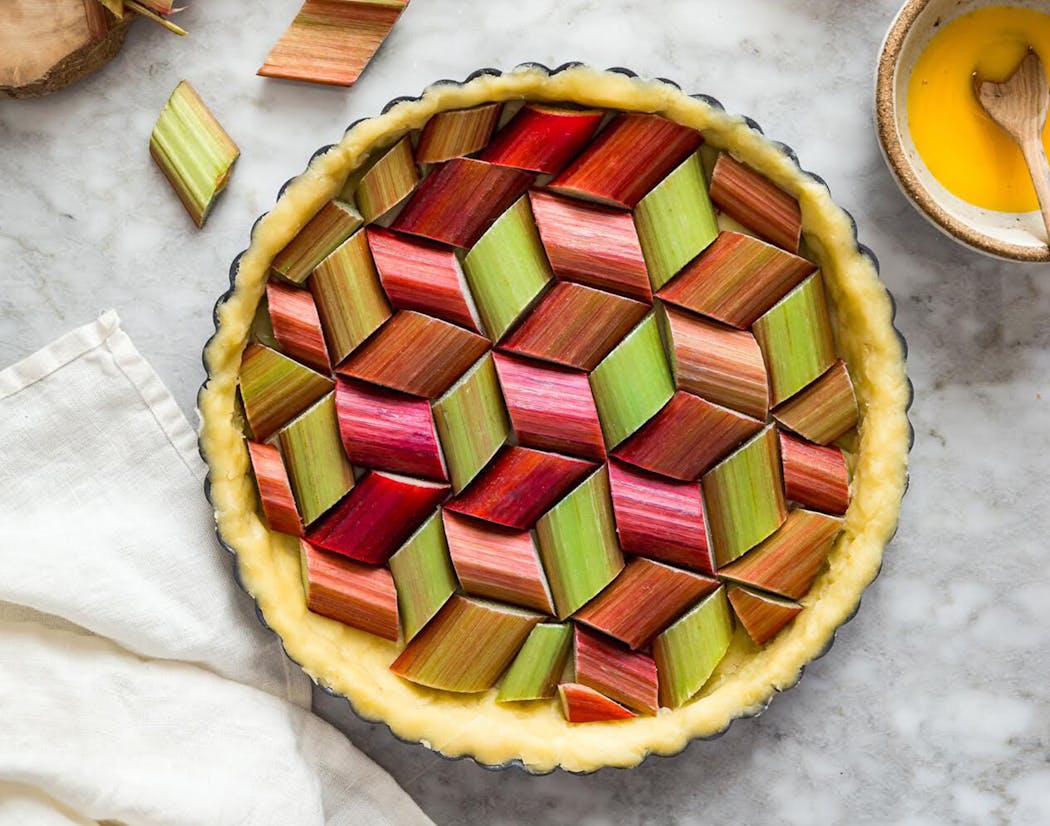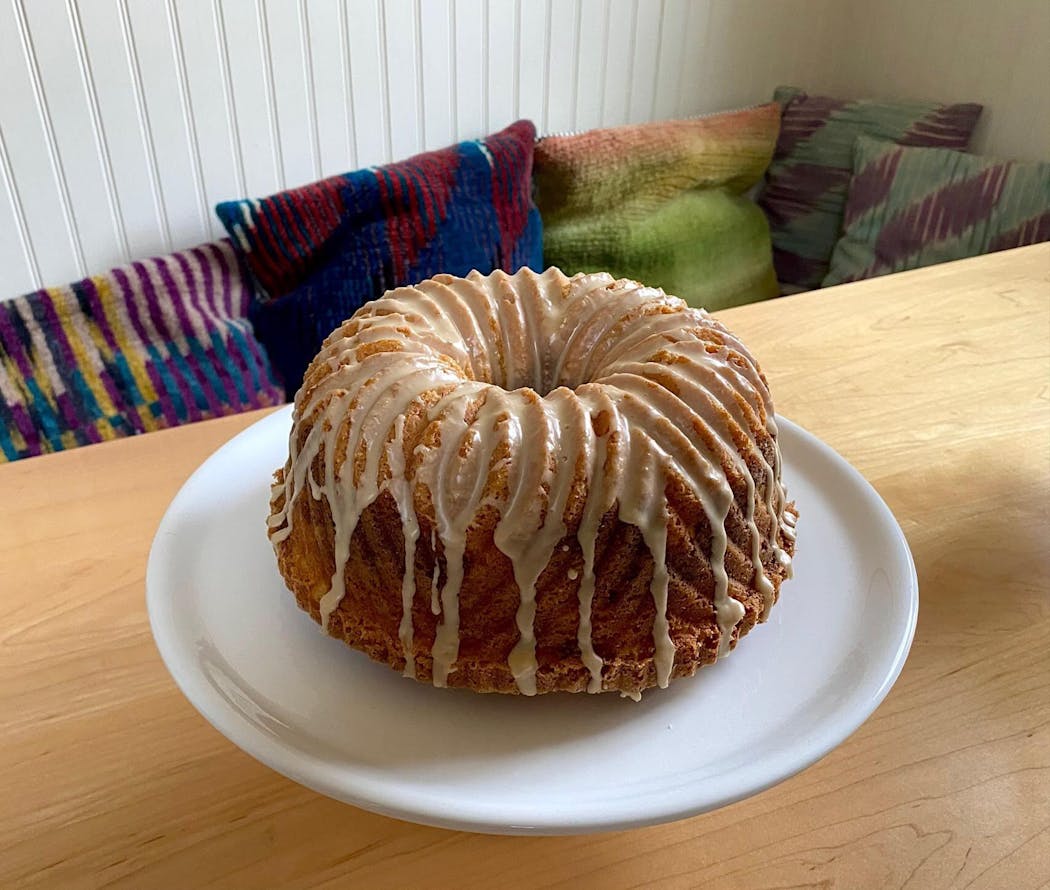Frank Adrian Barron and his now-husband, James, moved to Paris 10 years ago.
It was January, and when Barron, a transplanted Californian, hit the produce section at a nearby supermarket in search of smoothie ingredients, he was confronted by a distressing reality: no strawberries.
"The French, I'd quickly find out, preferred to eat by the season, buying fruits and vegetables right when they're harvested, when their flavor is at their natural peak," he writes in "Sweet Paris: Seasonal Recipes From an American Baker in France" (Harper Design, $29.99). "Though I was aware of this practice in theory, it wasn't how we ate where I was from, a land where everything is available at any time."
That experience marked the start of Barron's foray into the French way of eating. That wasn't the only change he was making. Within a year, the art historian was immersing himself in a new-to-him avocation, cake baking.
"I was missing home and wanted to go back," he said in a recent interview. "I didn't speak French, I didn't have a work visa, I felt lost. I turned to baking at home for the nostalgia, and because I missed American-style cakes — Bundt cakes, coffee cakes, banana bread, chocolate cake with buttercream — which are impossible to find in France."
After a lot of trial and error — and watching countless YouTube instructional videos — Barron found himself fulfilling cake requests among his expat friends. That grew into baking cakes for coffee shops and pop-ups, then hosting cake decorating classes in the couple's apartment in the city's Marais district. A blog (cakeboyparis.com) and a popular Instagram account (@cakeboyparis) led to the just-released "Sweet Paris."
"I kind of let the cake journey take me where it was going to take me," he said. "I did not count on it becoming a second career."
"Sweet Paris" is beautiful to look at (thanks to captivating photographs by Joann Pai) and a treat to read, with approachable and appealing recipes that are seasonally influenced and reflect Barron's American background and his adapted French sensibilities: lavender honey madeleines and white peach tarts in the summer, persimmon Bundt cakes and apple-cardamom tea cakes in the fall and chestnut cakes and orange-glazed gingerbread in the winter. Right now? Rhubarb, of course.
In a recent phone conversation, Barron discussed his household's sweet-tart continuum, the beauty of Bundt pans and the glories of Italian meringue buttercream.
Q: What draws you to rhubarb? I was surprised to learn that it's a relatively new-to-you ingredient, because your recipes for rhubarb land squarely in the "gotta-make" category.
A: I don't recall having a lot of rhubarb when I lived in San Diego and San Francisco. For the French, it probably wouldn't make the Top 5; it's the U.K. that really celebrates rhubarb. But it was important for me to include rhubarb in the book because it's my husband's favorite. My interests are more on the sweet side, but his flavor profile is Team Tart, all the way, so he leans to things like lemon and rhubarb.
Q: Your Tarte à la Rhubarbe is beautiful, and delicious. Why the tart format?
A: For the French, a tart is their go-to for when it comes to highlighting a particular flavor, because it's a beautiful base for showing off the ripeness of the featured ingredient, like rhubarb.
Q: After a decade of living in Paris, is there a seasonal ingredient that you anticipate eating — and baking with — every year?
A: My favorite season for baking is the fall, and one of the reasons is because that's when the Mirabelle plum comes into season. It's a tiny golden plum, bursting with flavor, from the Lorraine region, and I'd never heard of it or tasted it until we moved to Paris. It's only in the markets for about two weeks. During that time, everyone goes crazy and buys them by the bucketload, and you see them in tarts in boulangeries all over Paris.
Q: I love it that you're so into Minnesota-made Nordic Ware Bundt pans. What's the story?
A: My mom's specialty cake was a cinnamon Bundt cake, and my homage to that cake was my first attempt at baking cakes. The Bundt shape is a very American thing, it's very nostalgic for me. Bundt cakes tend to look a little extra-fancy, like you went to all of this work, but the pan does all the work.
Q: How many Bundt pans are in your collection?
A: At least six, and they're all beautiful. I worship Nordic Ware. Their Bundt pans are hard to find in France, so I always try to take one back with me.
Q: When you were selling layer cakes to coffee shops, what feedback did you receive regarding American buttercream frosting?
A: That the American customers loved it — it's pure deliciousness — but the French customers were pulling all the buttercream off the cake and leaving it on the plate. Sacrilege! It's the best part of the cake — cake is basically a vehicle for the frosting — and it's what I grew up eating. But then I discovered and learned all about Italian meringue buttercream. It has lots of complicated steps, but the result is a vastly less-sweet frosting. It's also really easy to use, because it stays soft and airy. I was like, "OK, this is a winner," but my heart still belongs to American buttercream.
Q: Do you have any advice for first-time cake bakers, who might be intimidated at the prospect of baking a cake?
A: This might sound basic, but my advice is to very closely follow the directions. Baking is not the same as cooking. With 99% of baking, it is imperative that you follow the exact measurements and instructions to a T, or else the recipe won't work out. I've had many cake fails over the years, and that's how I also learned that prepping — cutting parchment paper, dusting the pans with flour — isn't fun, but if you skip it, you'll have less-than-perfect results.
Q: Is there a cake in the book that to you is most emblematic of Paris?
A: My plan was to do a lot of cakes that were a mix of flavors and styles. The one that most closely matches a classic French cake is the gâteau opera, which is the famous chocolate-coffee cake created in Paris and inspired by the Opera Garnier. I love coffee and chocolate. The original is a very petite, elegant, rectangular cake, with chocolate ganache and edible gold leaf. I tried to keep my version as close to the original as possible, but I supersized it into a giant layer cake. Voilà, the American version.
Q: Do you have any cake recommendations for folks traveling to Paris this summer?
A: For something American, Treize Bakery is a beautiful cafe facing the Luxembourg Gardens. It's owned by an American woman, and she serves coffee and tea and tons of layer cakes. It wasn't around when I first moved to Paris. For something more Parisian, Mori Yoshida is a Japanese/French pastry chef, and in the spring and summer he makes fraisier cakes — strawberries, with the lightest génoise, and whipped cream — and it's one of my favorite things to eat in Paris.
Tarte à la Rhubarbe
Serves 6 to 8.
Note: This dough must be prepared in advance. "The tart design was inspired by a flawless version created by a fellow baker/Instagram friend, Thida Bevington," writes Frank Adrian Barron in "Sweet Paris." "Feel free to arrange them in any design you like — the end result will be just as delicious."
For the dough:
• 1 2/3 c. flour, plus extra for rolling dough
• 2/3 c. powdered sugar
• 1/4 c. almond flour
• 1/2 c. (1 stick) unsalted butter, at room temperature and cut into small pieces
• 2 egg yolks, lightly beaten
• Pinch of fine sea salt
For the frangipane:
• 3/4 c. granulated sugar
• 1/2 c. (1 stick) unsalted butter, at room temperature
• 2 eggs, at room temperature
• 1 c. almond flour
• 1 tsp. almond extract
• 1 tbsp. flour
For assembly:
• 3 to 4 large rhubarb stalks (about 18 oz.), cut into diagonal pieces
• 2 tbsp. honey, warmed
• Vanilla ice cream, for serving
Directions
To prepare dough: In a bowl of an electric mixer on low speed, combine 1 2/3 cups flour, powdered sugar, 1/4 cup almond flour, 1/2 cup butter, egg yolks and salt, and mix until a dough forms, about 2 to 3 minutes. Do not overmix. When the dough comes together, shape into a disc, wrap in plastic wrap and refrigerate until firm, at least 1 hour.
Remove the dough from the refrigerator 30 minutes before you plan to roll it out. When ready to bake, preheat the oven to 400 degrees.
Transfer the dough to a lightly floured work surface. Using a lightly floured rolling pin, roll out the dough to a large circle, about 12 inches in diameter. Carefully roll the dough around the rolling pin, brushing off any excess flour. Unroll the dough over a 9-inch tart pan with a removable bottom, gently tuck the dough into the pan, and trim any excess dough. Using a fork, poke tiny holes across the bottom of the tart shell. Line the tart shell with parchment paper and fill with pie weights to keep the dough from puffing up during baking. Bake for 10 minutes. Remove the tart shell from the oven, and carefully remove the pie weights and parchment paper. Return the tart shell to the oven and bake until the center turns golden, about 10 to 12 minutes. Remove the tart shell from the oven and transfer to a wire rack to cool completely.
To prepare frangipane: Meanwhile, in a bowl of an electric mixer on medium speed, combine the granulated sugar and 1/2 cup butter and beat until pale, about 3 to 4 minutes. Add the eggs and mix until combined, then add 1 cup almond flour and almond extract, and mix until smooth. Add 1 tablespoon flour and mix until fully incorporated. Refrigerate until ready to use.
To assemble tart: Spread the frangipane filling evenly over the cooled tart shell. Press the rhubarb pieces into the frangipane in desired pattern. Bake until the edges of the tart shell are golden brown, about 30 to 35 minutes (if the edges start to get too brown, cover them with aluminum foil). Remove the tart from the oven and transfer to a wire rack to cool. Carefully brush the top of the tart with warm honey for a glossy finish, and serve with vanilla ice cream.
Cinnamon Swirl Bundt Cake
Serves 12.
Note: Frank Adrian Barron based this recipe on his mother's signature cake. "Her version incorporates sour cream, which I substitute here with crème fraîche, because it has a richer flavor due to its higher fat content," he writes in "Sweet Paris." "Everything else, however, is kept the same, right down to the maple glaze she would allow me to pour — with a watchful eye."
For the cake:
• 1 c. (2 sticks) unsalted butter, at room temperature, plus extra for pan
• 3 c. flour, plus extra for pan
• 2 tsp. baking powder
• 1⁄2 tsp. fine sea salt
• 2 c. granulated sugar
• 5 large eggs
• 8 oz. crème fraîche
• 1 tbsp. vanilla extract
• 1⁄4 c. firmly packed dark brown sugar
• 2 tbsp. ground cinnamon
• 2 tbsp. whole milk
For glaze:
• 1 c. powdered sugar, plus additional as needed
• 1⁄4 c. maple syrup, plus additional as needed
• 1⁄2 tsp. vanilla extract
Directions
To prepare cake: Preheat oven to 350 degrees. Grease and flour a 10- to 12-cup Bundt pan and set aside.
In a medium bowl, whisk together the flour, baking powder and salt, and set aside.
In the bowl of an electric mixer on medium speed, beat the butter and granulated sugar until pale and fluffy, about 4 minutes. Reduce speed to low and add eggs, one at a time, scraping down the sides of the bowl with a rubber spatula between additions. Add the crème fraîche and 1 tablespoon vanilla extract and mix until just combined. Add the flour mixture in three additions, mixing until just combined.
Transfer about 2 cups of the batter to a medium bowl. Add the dark brown sugar, cinnamon and milk, and stir until smooth.
Pour about a third of the plain cake batter into the bottom of the prepared Bundt pan, then pour about half of the cinnamon batter on top. Repeat to add a second layer of plain batter, followed by a second layer of the remaining cinnamon batter. Finish with a third layer of the remaining plain batter on top. To make the marble swirl, use the point of a butter knife to draw a zigzag pattern through the batter. Bake until a cake tester inserted into the center comes out clean and the cake is golden brown, about 55 to 60 minutes. Transfer the cake to a wire rack to cool for 15 minutes before carefully inverting the cake on a wire rack, removing the pan and allowing the cake to cool completely.
To prepare glaze: In a small bowl, whisk together the powdered sugar, maple syrup and 1⁄2 teaspoon vanilla extract until well-combined and smooth. Add more powdered sugar or maple syrup as needed to create a thick but pourable glaze. Place a sheet of parchment paper underneath the wire rack holding the cooled cake. Slowly pour the glaze over the top of the cake, allowing it to drip down the sides. Allow the glaze to set at room temperature for about 15 minutes before serving.
Vanilla Bean Panna Cotta
Serves 4.
Note: This recipe must be prepared in advance. "You'll have a fair bit of extra rhubarb sauce left from this recipe," writes Frank Adrian Barron in "Sweet Paris." "It makes an excellent topping over ice cream or your morning yogurt."
For sauce:
• 1 lb. (4 to 5 large stalks, or 7 to 8 small stalks) rhubarb, cut into 1 1/2-inch batons
• 1⁄2 c. plus 2 tbsp. sugar
• 2 tbsp. freshly squeezed orange juice
• 1⁄4 c. water
For panna cotta:
• 2 1⁄2 tsp. powdered gelatin
• 1 tbsp. boiling water
• 2 c. plus 4 tsp. heavy cream
• 1⁄4 c. sugar
• 1 vanilla bean, split lengthwise
Directions
To prepare sauce: In a large saucepan over low heat, combine the rhubarb, 1⁄2 cup plus 2 tablespoons sugar, orange juice and 1⁄4 cup water and bring to a simmer. Continue simmering until the rhubarb is tender and the syrup is thick, about 8 to 10 minutes. Remove from heat and transfer the rhubarb and syrup to a shallow dish to cool.
To prepare panna cotta: In a small bowl, sprinkle the gelatin over the boiling water. Stir and allow to bloom, about 3 to 5 minutes.
In a small saucepan over medium heat, combine the heavy cream and 1⁄4 cup sugar. Using the tip of a sharp knife, scrape the seeds from the vanilla bean into the pan. Bring the mixture to a gentle boil, stirring occasionally. Add the bloomed gelatin mixture and stir until incorporated. Remove from heat. Divide the mixture among four glasses (or ramekins) and allow to cool to room temperature. Transfer to the refrigerator to set, at least 3 hours or overnight.
To serve: Add 2 to 3 pieces of rhubarb, along with some rhubarb syrup, to each glass (or ramekin) before serving.
The summer after Barbenheimer and the strikes, Hollywood charts a new course

Gophers football coach P.J. Fleck lists 'resort-style' Edina home for $3.9 million
Mexican film wins top prize at Moscow International Film Festival while major studios boycott Russia
Why you might have heard Paul Simon's 'The Sound of Silence' at Spanish Mass





